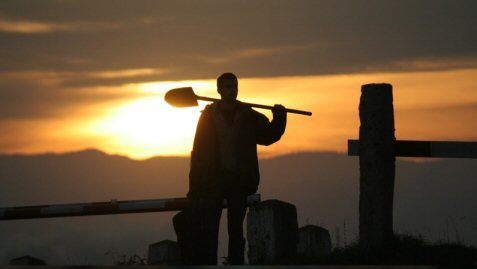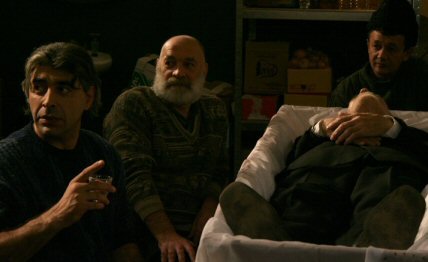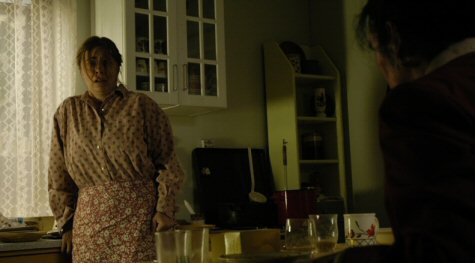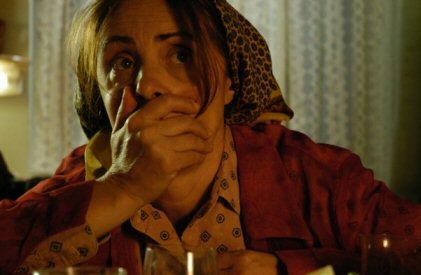Itís always heart-warming to see horror reclaim its legacy from the mainstream and with the release of modern gothic chiller STRIGOI, we see the return of the vampire to its roots - to celebrate the incoming DVD release by Bounty Films in the UK our very own bloodsucker Stu Willis climbed out his coffin for a candid chat with filmmaker Faye JacksonÖ

Stu: Hi, thank you very much for taking the time to answer a few questions. Firstly, Iíd like to say how much I enjoyed STRIGOI. Itís excellent. How did the idea of a Romanian-set horror film develop though: were you aware of the mythology first, or was it the love of the country that fired your inspiration?
Faye: It was the country that inspired me first. My husband is Romanian, so Iíve been visiting regularly over the past ten years. The country is changing so fast, and there were so many things I wanted to get down on film before they disappear. And when I discovered the strigoi myth, it immediately struck me as a great way to tell a story about family and history and the way corruption survives.
Stu: You chose to use actors local to your location in the film, but had them speak English throughout. It works well. What were the logistical reasons for this approach though? And did you encounter many headaches in the process?
Faye: I had to write it in English. My Romanian isnít nearly good enough to write in Romanian and I didnít think translating an English script into Romanian would work (plus my producer, who is Romanian, kept saying it should be in English).
We decided that we would try to cast Romanian actors first and only look elsewhere if we had to. It was really frustrating sometimes because it was another element that could go wrong (great shot, killer performance, slight mispronunciation), but Iím so glad we did it that way, I canít imagine any other actors inhabiting the roles as well.
Stu: The film offers a fresh take on the vampire genre, mixing folklore with some very contemporary humour. I felt it owed something in this respect, as well as in tone, to CRONOS. Do you agree with this observation?
Faye: CRONOS was a reference point for the film. I wanted to do something that had a feeling of being rooted in folklore rather than Hollywood and CRONOS is about as good an example of that as I can think of. Funnily enough, I met Guillermo Del Toro very briefly when my short film LUMP played in front of PANíS LABYRINTH at the New York Film Festival. I didnít really get the chance to annoy him about how much I like CRONOS (and PANíS LABYRINTH for that matter), but I may have drunkenly harassed Guillermo Navarro about it.

Stu: Could you tell us a little about your cast? Their backgrounds, how they came to be involved in your production, and how everything fell together?
Faye: I must have met every English-speaking actor in Romania when we were casting STRIGOI. It was tough because not only did we need really good actors, they had to have good English and be perfect for each role. Certain parts were harder to cast (at one point, when I asked a casting director why he couldnít find any actresses over the age of 40, he suggested that they might all be dead).
Catalin Paraschiv (Vlad) and Constantin Barbulescu (Constantin) are both primarily screen actors, but most of the rest of the cast are theatre actors. I knew Constantin before (heís been in "The Bill"!) and I went around asking everyone who read the script who Vladís character made them think of until Catalinís name came up. Camelia Maxim (Mara) is a very well respected theatre actor and only does the occasional film. We were very lucky that her husband happened to come in one day and take the script back for her to read. I knew she was Mara the minute she walked in. Both Rudi Rosenfeld (Nicolae) and Roxana Guttmann (Ileana) work at the Jewish Theatre in Bucharest (they both also had small roles in Coppolaís YOUTH WITHOUT YOUTH). Roxana was the only actor who really ate at the auditions, and Rudi was a bit of a revelation (I thought he was good but he turned out even better). And, yeah, I think the rest of the cast also have theatre backgrounds. There are loads of screen actors in Romania, but thereís a huge repertory theatre tradition and most actors earn their bread and butter that way.
We had a couple of weeks rehearsal, but what was really great was going on location in Podoleni village in the north of Romania (Moldova county). Everyone was in character (more or less) and they all had fun interacting with the real villagers (who sometimes had no idea they were talking to actors).
Stu: You are known as an editor as much as a director. Two questions: (a) which do you consider yourself to be first and foremost, and (b) whatís the greatest benefit of being an editor when working as director.
Faye: I think of myself as a film-maker, and writing, editing and directing are just different stretches along the same path. A background in editing is really good because when someone on set says "they can fix it in post", you can say with confidence "no, they canít, letís get it right now".

Stu: STRIGOI has a quirky, unforced manner about it. As well as a stylised one. It fits ill with present-day genre films Ė in a good way Ė recalling early 90s films such as CRONOS, JACK BE NIMBLE and CEMETERY MAN. Iíd like to know though which films you were specifically influenced by, and in what capacity?
Faye: When I write, I just think in terms of the story and the world of the characters, I donít consciously think of other films. When we were in pre-production it was hard to talk about STRIGOI to people without mentioning BLACK CAT, WHITE CAT, which is probably the most life-affirming movie ever made in Eastern Europe. It creates a very particular movie world, but that world is also very recognisably based on something real, and thatís what I wanted to do with STRIGOI.
And I ended up re-watching MILLERíS CROSSING a few times. I love the plotting and the tone of the film, I love the way it pulls off drama and comedy and melancholy all at the same time. Both 90s films!
Stu: What research went into making the film? From exploring the folklore, to observing the culture: Iíd love to know how you prepared for the film, as it genuinely appears to have been immaculately conceived.
Faye: The "research" for the film was totally organic. As I mentioned, my husband is Romanian (and now my daughter is half-Romanian) and Iíve spent a lot of time there over the past 10 years sitting in the corner at social things trying to figure out what the hell is going on. My husband has family in Podoleni village (where we shot) and Iíve always loved to visit. And every time a particular character or attitude or tradition or has interested me or made me laugh it got added to the pot.
Stu: There is a recurring theme of food throughout the film. Can you discuss this?
Faye: The food thing is a bit of a joke about Romanian hospitality. Most countries have a "food" thing, but in Romania you better not go visiting unless you have room for a five course meal. They will make you eat it.
Stu: Youíve made a quality vampire film. I think that puts you in a perfect position to comment upon the TWILIGHT films...
Faye: I havenít watched the Twilight films so I shouldnít really comment (I know, where have I been?). Iím really not the target audience. I think itís funny when people get so annoyed at Justin Bieber or what ever crap it is theyíre selling to kids nowadays (in my day it was Wham! And TOP GUN so who am I to judge?). I do think itís cool that there is such a huge franchise marketed at teenage girls when the movie juggernauts are usually made for boys. They canít be any worse than the Transformer movies, can they?
Okay, sure, maybe it would be nice if there was a bigger market for grown up films.

Stu: STRIGOI has been winning acclaim since its release, even winning the award for Best Independent Feature at Torontoís After Dark festival. Have you been witness to many/any of the filmís festival screenings? How have you found the reactions to be?
Faye: Iíve been to a number of the North American festival screenings, a Swedish one and a UK one (with an audience full of Romanian dentists, brilliant). Itís great (if nerve-wracking) to be there when people see it. The screening thatís really burned in my memory is the first at Toronto After Dark. I kept thinking "Oh no, what have we done, what will all these Canadians think about a bunch of Romanians hitting each other over the head with spades?", but the reaction was great. The festival director encouraged everyone to go around shouting "Strigoi!", so people would just yell it at us as we passed. Iím thrilled that it has played so well over the world. For a while we seemed to keep getting awards in South America and Iím sorry I never got the chance to go and find out why they liked it so much there.
Stu: On the UK DVD, we get your earlier short film LUMP. What a disturbing short! Could you tell us a little more about this film, from its conception to its motive, and how it was made?
Faye: Iíve always found general anaesthetics really creepy: you fall asleep, then when you wake up bits of you are missing. LUMP is a little mystery built around those fragments of lost consciousness. It was shot on 35mm over a couple of weekends and played all over the world (in fact, it still gets screened on occasion). Lara Belmont stars and she is fantastic.
Stu: Whatís next? Have you got anything in the pipeline?
Faye: Iím developing a couple of features, both set in London: a thriller about a marketing company thatís using CCTV to read peopleís minds, and another fantasy/comedy/horror where a modern scheherezade tells a series of urban fairy tales.
Stu: Thanks again for your time and all the best with the film, it deserves a wide audience.
Faye: Thank you for the great questions, Iím really happy you enjoyed STRIGOI.
Special thanks to Faye Jackson and Steve at Bounty Films